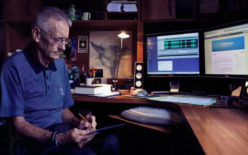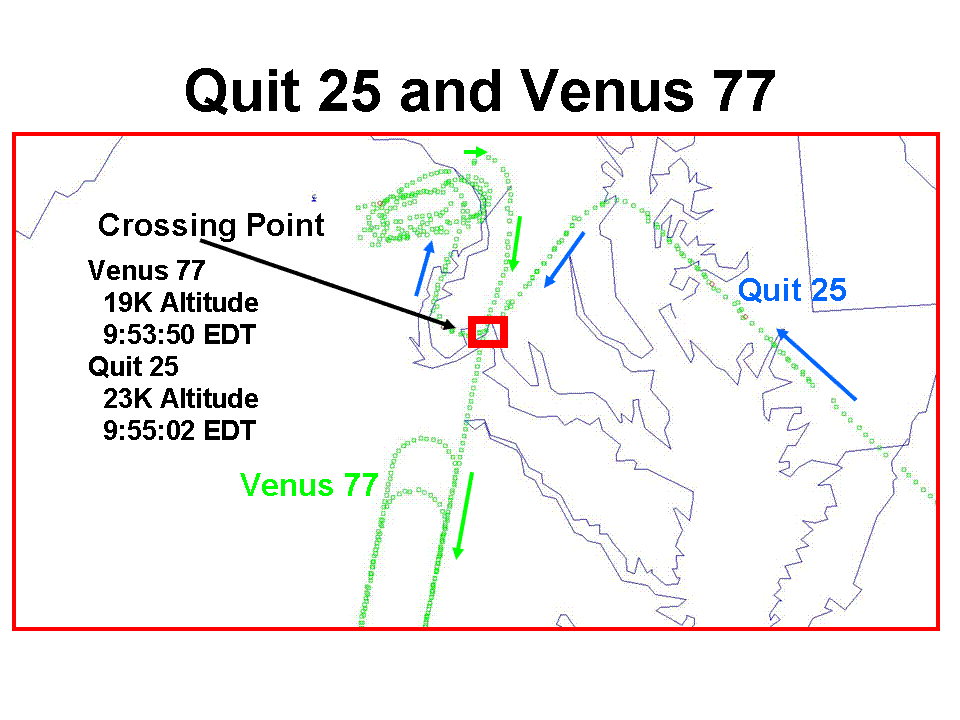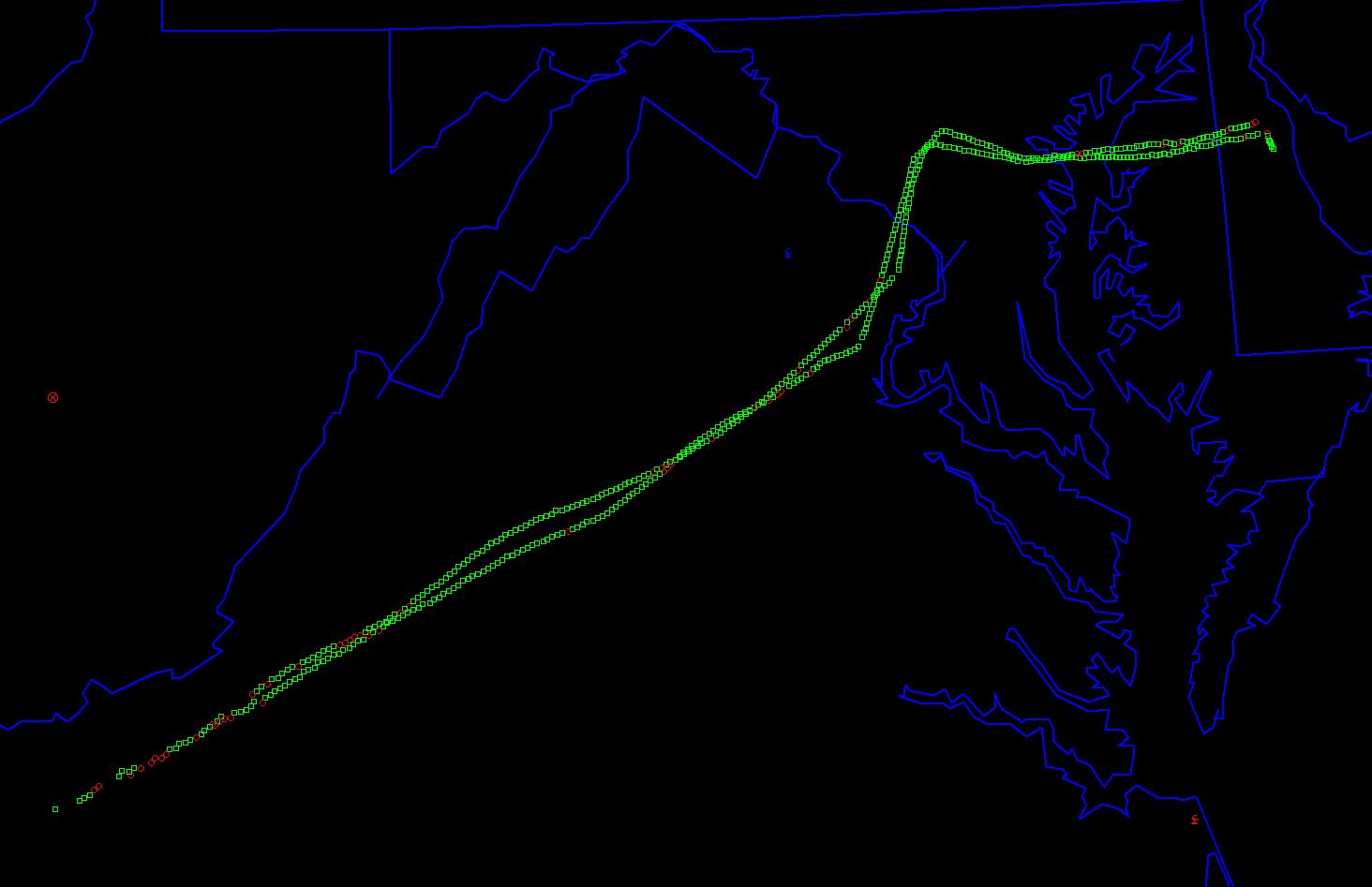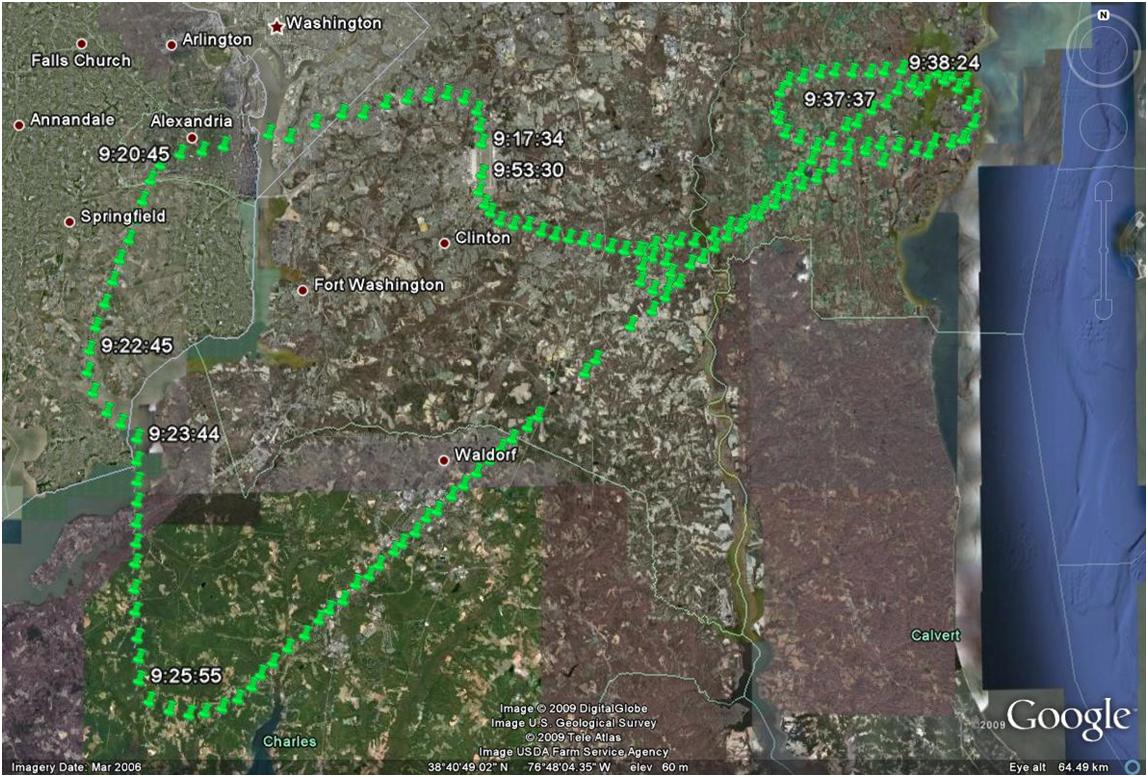Introduction
Periodically, the false notion surfaces that there was some relationship between the Langley fighters (Quit 25, 26, 27) and the B747, Venus 77, a NEACP flight (National Emergency Airborne Command Post). Despite a cursory screen print that suggests a relationship there is no correlation. The two flights were independent events whose paths crossed as they flew to complete their assigned tasks. There is no primary source evidence that links the two paths. The crossing was incidental.
Also, there is an occasional comment in the blogosphere questioning why military aircraft didn’t immediately land when Ben Sliney ordered all planes to the ground and why aircraft such as Venus 77 were allowed to take off. First, it was not clear to FAA facilities if Sliney’s order pertained to law enforcement, first responder, and military aircraft. Readers familiar with the FAA tapes of the day know that multiple FAA facilities raised that very question to the Air Traffic Control System Command Center. That question was also raised by “Navy Ops” to Andrews Tower at 9:37. The answer given was “that we will know in about 20 minutes.” Ultimately, all such aircraft were allowed to fly. Here is the conversation that took place at Andrews Tower which should lay to rest any notion that military aircraft should not be flying.
We will know in about 20 minutes
Quit 25 and Venus 77 flight paths and missions
Here is a complete radar-derived graphic that shows the spatial relationship between the two planes and their separate missions. The graphic is a screen import into first powerpoint and then paint from the files of the 84th RADES as run on the RS3 software. (Click on the graphic for a non-distorted view.)
Venus 77 (Mode 3 0321) took off abruptly from Andrews Air Force Base at 9:43 EDT, soon after the National Military Command Center (NMCC) initiated an Air Threat Conference Call. It declared for Offutt Air Force Base and turned West. Over Rock Creek Park/Silver Spring, it changed course and returned East and then immediately South to establish a 60-mile, North-South, race track orbit centered on Richmond, Virginia. By 10:00 EDT, it was in position to support the return of Air Force One to the nation’s capital. Later, after Air Force One headed toward Barksdale Air Force Base, Louisiana, the orbit was adjusted so that its long axis pointed to Barksdale.
This next near-two minute audio clip recorded at Andrews documents the takeoff and original intention of Venus 77. This establishes that its original destination was Offutt Air Force Base. In other articles I believe I have stated the destination to be Wright Patterson Air Force Base; not the case. Venus 77 is further identified as a “Knee Cap” (NEACP), Boeing 747. This is further evidence that the abrupt departure of Venus 77 was part of the continuity of operations plan triggered when the NMCC changed its Significant Event Conference to an Air Threat Conference.
While over Northeast Northwest [corrected Dec 18, 2012] Washington, DC, the B747 was filmed by the media and it later became the so-called “mystery plane.” I wrote about that several years ago in the linked article. I have also previously covered, in detail, the Langley flight, in several articles, including this most recent one. There is no mystery here, either.
In the graphic, above, I have isolated the Quit and Venus tracks based solely on the Oceana radar. Even so, it is clear that beginning over the Maryland portion of the Delmarva Peninsula there are two radar returns for the Quit flight. That is the point at which the wingman, Quit 26, also switched to Mode 3, 7777, “Quad Sevens” in the vernacular. Both fighters were squawking the same code and are only distinguishable in the RADES text files where the lead and wing can be separately identified.
The Crossing Point
The paths of the two planes crossed over Charles County, Maryland, due east and across the Potomac River from Stafford, Virginia. Venus 77 crossed first at 9:53:50 EDT at 19,000 feet. Quit 25 crossed next at 9:5502 EDT, at 23,000 feet. Their closest point of convergence was about 5 nautical miles with a 4,000 foot separation in altitude. Neither knew the other was there. Venus 77 proceeded directly to its orbit and at the point of crossing Quit 25 began its turn back on course after being given a correct set of Combat Air Patrol (CAP) coordinates.
The time separation is precise, six radar returns, one minute and twelve seconds. I’ve made the 25 second correction necessary for the NEADS radar clock for the individual crossing times. The radar clock adjustment is irrelevant, however. The two flights were also tracked by the Southeast Air Defense Sector, whose radar clock needed no correction.
The Quit flight was on a heading for Baltimore (Baltimore Washington International Airport, actually.) The tactical decision after takeoff and back under NEADS control was to put the fighters between Washington DC and the reported approach of American Airlines flight 11. Once NEADS learned of the fast mover (American Airlines flight 77) threat to Washington DC the Quit flight was placed under AFIO (Authority for Intercept Operations, squawk Quad 7s) on its Baltimore axis of approach. Once abeam the Capital and Andrews Air Force Base the flight leader was given the CAP coordinates, transposed at first, and then corrected.
The following NEADS audio clip describes what happened at 0953 EDT just as the Quit flight was approaching the crossing point. It is conclusive that Quit 25 had been given the wrong coordinates and heading and that was corrected with the correction emphasized by Quit 25. Immediately, the Quit flight began its turn back to the North just as it crossed well behind the path of Venus 77.
0953 Quit approaches crossing point
Two points of clarification concerning the conversations heard. First, the Giant Killer reference was part of a radio transmission from the air, most likely from Team 21, a tanker being staged to support air defense activity. Second, the reference to “zero three two” is the specific point of interest to the Langley weapons controllers. That is a reference to the last known location of track B032, AA 77, in the vicinity of the Pentagon. Six minutes later, at 10:00 EDT, one of the Quit fighters was directly overhead the Pentagon at 23,000 feet as the flight began its assigned mission, a combat air patrol. None of that had anything to do with Venus 77 which continued south to fly a precise race track orbit centered on Richmond, Virginia, as clearly depicted on the graph, above.
The fact that the weapons controllers were focused on track B032 is, in and of itself, evidence that they had no interest in Venus 77.
AFIO
[Added January 12 2012: The precise term is “Authorization for Interceptor Operations.” FAA Handbook, 7610J, Appendix 16, dated Nov 3, 1998 details the authorization, conditions, and responsibilities and procedures. The Appendix does not specify a specific Mode 3 code for the interceptor fighters, but the convention was, and is, that the fighters would switch to Mode 3 code 7777, ‘quad sevens.’]
The declaration of AFIO was a serious move, with broad implications; NEADS assumed responsibility to clear a path through traffic for the advancing fighters. Air traffic control was still in contact with the Quit flight but was no longer responsible for air traffic safety in the vicinity of the fighters.
The more important point is that NEADS, and only NEADS, had positive control of the fighters. There can be no notion, no matter how speculative, that someone else directed the fighters toward Venus 77. It was a weapons controller error at NEADS, pure and simple, the transposition of two digits in the initial CAP coordinates.
Further, had Venus 77 been any kind of air traffic hazard because of proximity, there would have been advisory weapons controller communications to that effect. There were none.
Comment
This story is straight forward. Two flights with two different missions happened to be in the same general area in the same general time frame. There is no evidence to correlate the two flights. Speculation to the contrary is, at best, misguided analysis without primary source or other evidence to the contrary.



